Extreme Networks 802.11ac Wave 2 ─ new generation wireless solutions
All IT managers actually pursue the same goals - reducing costs, increasing end-user productivity, and aligning IT operations with the organization's business goals. It is clear that any technologies that contribute to the fulfillment of these goals should be carefully considered. These include those that Extreme Networks is developing in the area of wireless networks.

Extreme Networks develops and delivers managed network solutions that help IT organizations improve their bottom line business results through closer connections between customers, partners, and employees.
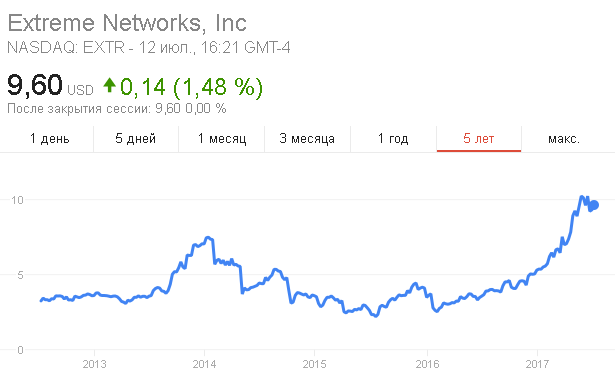
In the last five years, the value of Extreme Networks shares did not undergo significant changes, and in the last year, with the advent of Wave 2, it has steadily increased
')
Today, Wi-Fi is the best in technology and the most convenient connectivity for users, ─ in any organization and for almost all mobile devices and applications. Therefore, the high interest of customers in solutions based on the 802.11ac Wave 2 standard is not surprising.
Improvements in wireless technologies, radio design, building access points, as well as the practice of implementations over the past two decades have already spawned several network generations: 10 Mbit / s, 100 Mbit / s, and now with 802.11ac ─ 1 Gbit / s. In fact, 802.11ac Wave 2 achieves a throughput of 1,733 Gbps.
It is important that 802.11ac Wave 2 not only provides high bandwidth, but also allows you to use almost any device and transport connection with higher performance and lower cost than ever before.
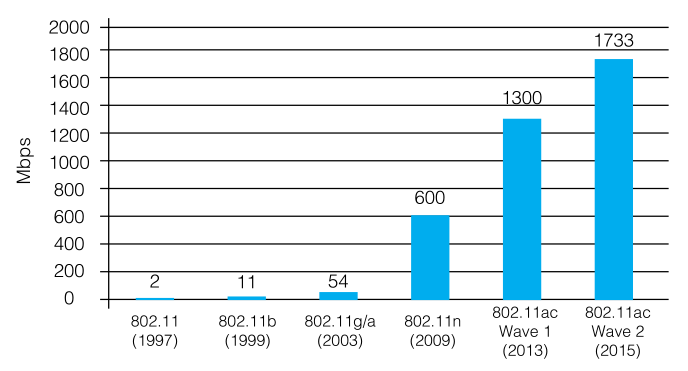
Increase Wi-Fi performance over the past 20 years
IT managers today are forced to work with reduced budgets while simultaneously requiring more and more efficiency. In this regard, the search for arguments to justify new investments from a business point of view comes to the fore.
Below are five key components of the business case for using Wave 2.
1. Understand the Benefits of Using Advanced Wireless Technologies
When discussing wireless solutions, they usually talk about their bandwidth. However, it is no longer the main problem of Wi-Fi, especially since we are talking about the generation of Wave 2 from 1.7 Gbit / s. This is quite enough to solve the majority of modern corporate tasks.
A much more important issue is ensuring support for a large and growing number of users, devices and applications, many of which use real-time audio playback and streaming video.
Even with a 33% improvement in peak throughput compared to Wave 1, Wave 2 technologies are more evolutionary than revolutionary. They are based on 802.11n innovation and are not too fundamentally different compared to 802.11ac Wave 1.
Improvements include greater spectral efficiency (fewer errors) and MIMO (Multiple Input / Multiple Output) ─ the ability to use space, not just frequency and time, which greatly increases throughput.
An additional innovation, called "beamforming", is also part of the 802.11ac standard. In a simplified presentation, beamforming is the ability to concentrate radio transmissions in the direction optimal for communications between a given access point and the client at any time, as well as to make adjustments in real time to compensate for movements and other conditions of the radio environment.
To date, all but very few products on 802.11ac have provided at most three MIMO streams, each with a maximum throughput of 433.3 Mbit / s under optimal conditions. Wave 2 works with four streams, providing 1,733 Gbps.
Interestingly, the 802.11ac standard actually defines up to eight streams. However, products that do this in practice are unlikely to become common because of their complexity and cost (at least in the foreseeable future). In addition, today most client side devices support only one (less often two) streams.
Vawe 2 Multi-User MIMO technology allows multiple users to accept a transmission that is unique to each client in a single transmission from a given access point. That is, there is no need to wait for other users to be served and to waste potential bandwidth. As a result, efficiency rises dramatically along with end-user productivity.
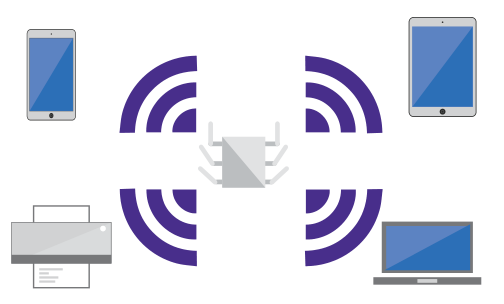
Schematic representation of the work of Multi-User MIMO
2. Maximum use of capital investments
Capital investments (Capital Expense, CapEx) are limited in the IT budgets of almost all companies, starting with a downturn in 2008. At the same time, the continuous flow of innovations in IT continues to affect infrastructure and equipment replacement cycles, although somewhat more slower pace than it was in the past. And, of course, careful consideration of absolute costs, and especially ROI, should today be part of all capital investment decisions.
As noted, for wireless LANs, the price / performance ratio improves with each new generation of products. But, in fact, this is due to an increase in their capacity, ─ while the prices of certain equipment (access points, etc.) remain unchanged or slightly reduced.
802.11ac Wave 2 products are fully backward compatible with Wave 1 (and even 802.11n). They work better than their predecessors, because they have a more advanced system architecture and firmware. Improvements have also affected their installations in a corporate environment that typically becomes seamless and stable.
Such an improvement in price / performance ratio with minimal installation costs raises an important question ─ is it really time to replace existing Wi-Fi solutions with Wave 2. There is no definite answer. Each organization must evaluate the purchase in terms of its depreciation cycles, available financial resources, and combination with the entire IT infrastructure and enterprise IT strategy.
However, it is obvious that any 802.11g (or earlier) solutions have definitely matured to be replaced, because too much has changed so far in terms of technical capabilities and WLAN value. Operating 802.11n systems will be under increasing pressure from Wave 2, especially if it makes sense to take advantage of the advantages of MU-MIMO.
3. Reduced operating costs
By definition, CapEx plus OpEx make up the Total Cost of Ownership (TCO). This is a key metric in determining the return on investment (ROI) and estimating capital costs over time.

Total Costof Ownership (TCO) Structure
While the 802.11ac Wave 2 capital cost component is understandable enough, operating costs (Operating Eexpense, OpEx) are a somewhat more complex subject to consider. The reason for this is that OpEx consists of aspects such as monitoring, management, support, troubleshooting, etc. They require the attention of qualified IT specialists.
Unlike CapEx, OpEx tends to increase over time ─ people become more expensive due to inflation and competition for special skills. Enterprises often cope with this problem by increasing the productivity of IT staff.
Therefore, the introduction of Wave 2 promises a significant increase in the productivity of employees of IT-departments. First of all, the improved performance of WLAN (bandwidth, capacity and support for time-limited communications, such as voice and video) will result in fewer calls to technical staff. In addition, Wave 2 will provide improved management and analytics, visibility of results and less time to troubleshoot.
And finally, regardless of how Wave 2 is implemented, ─ as a new deployment or upgrade, ─ flexible, stable and cheap seamless scalability is an integral part of Wave 2. Thus, any IT staff costs associated with the deployment of Wave 2, also minimized.
4. Improving end-user productivity
Any network strategy is best evaluated in terms of improving the performance of end users served by the network. As noted above, the number of users of wireless networks is constantly growing, ─ and not only in terms of the number of company personnel.
The spread of the Bring Your Own Device (BYOD) trend has caused a greater demand than ever before for services from users with several simultaneously active devices. Today, it is often possible to meet users who are simultaneously connected to a wireless network with two devices (a smartphone and a tablet). Not uncommon is the simultaneous use of three or four devices.
None of these devices (like the users themselves) love networks that are slow, inaccessible in certain locations, unreliable or not meeting growing needs, including support for streaming media, real-time telephony and other “heavy” communications.
New applications for the Internet of Things (IoT) also place additional demands on wireless networks. Of course, many IoT solutions will still operate with relatively little traffic. However, there are also quite heavy services ─ such, for example, as video surveillance and real-time processes. This means that the Wi-Fi network in which they operate will have needs at the Wave 2 level.
The more reliable and affordable a wireless LAN, the higher the end-user productivity. Therefore, to distribute wireless services in almost any organization, more and more MIMO and MU-MIMO streams are required.
The practical result of Wave 2 is that relatively small investments in new technologies can already provide a significant reduction in operating costs by maximizing productivity, and, accordingly, reducing TCO and increasing ROI.
5. Related Networking Technologies
Products based on 802.11ac Wave 2 embody the latest advances in features and technologies to optimize the entire chain of wireless networking. This applies to mobile clients, access points, controllers, switches and routers, management systems, etc.
Wave 2 is the technological foundation for modern wireless LANs. The network infrastructure will increasingly depend on new features and capabilities implemented in products based on Wave 2. Here are the main ones.
- Switching (Switchihg) . Wave 2 will require Power over Ethernet PoE + to realize its full potential.
- Management (Management) . This feature includes context-controlled monitoring, warnings and alarms, reporting, auditing, and more.
- Analytics . It is defined as a set of capabilities developed for the study of large amounts of data in conditions of uncertainty, that is, when it is difficult to accurately determine the subject of a search.
- Advanced security . Security is always one of the key elements on any network. Less and less, the WPA2 Wi-Fi feature is used for this (which, of course, remains important). Security is increasingly dependent on other network tools that are based on identification, access policies, context, content filtering, etc.
- Cloud . The key trend of today is the deployment of both wired and wireless networks ─ management and related functions in the cloud. The main advantages of cloud-based management ─ easy turnkey implementation, simple scalability, fault tolerance and increased security. The cost benefit of this approach is also significant, since the capital investments of the CapEx company are converted into a very economical version of OpEx.
- SDN . Software-defined networks will play a much larger role in wired and wireless networks in the coming years. The use of SDN improves network security, solution integrity, simplifies implementation, provides more comprehensive and high-quality management and analytics than traditional solutions.
Given the continuous stream of innovations in technology and Wi-Fi systems, another question arises ─ how soon will the next technology appear that will be able to supplant Wave 2?
Indeed, the IEEE 802 Standards Committee is working on new, even higher standards, but they are expected only after three years, and it will take at least five years before any of them becomes the mainstream in practice. Thus, the payback period for Wave 2 will be quite long, with a good economic justification.
Wave 2 Case Studies
This section discusses the benefits of using Wave 2 solutions in public places, education, industrial environments, corporate office networks, and healthcare.
Wave 2 in public places . Wireless traffic is growing rapidly in the hotel industry, in sports, in places of entertainment. All of them are characterized by a high density of users and devices. This motivates the demand for Wave 2 802.11ac.
Both problems and solutions for wireless LAN are often defined precisely in terms of density. Demands, after all, only grow over time. An example is IoT with its many new consumer devices, services and other applications.
Wave 2 in education . Education has always been one of the main consumers of wireless LAN. In the end, who consumes more bandwidth than students, ─ especially as the share of streaming video in the learning process increases? And who would want to go to school, where there would be no Wi-Fi?
But still, budget constraints often force many IT managers of educational institutions to use outdated systems. Wave 2 is a big step forward in solving this problem, providing greater bandwidth and being more cost-effective than any previous generation Wi-Fi.
In addition, the redundant capabilities of Wave 2 mean that the lifespan of these networks will be quite long. In a fairly conservative educational IT environment, this is an important factor.
Wave 2 in production . The production environment is usually quite complex to configure Wi-Fi services. Reliability is the most important element for wireless solutions in workshops and distribution centers, as they are related to the management of continuous flows and business processes. There may be adverse climatic conditions and radio frequency interference. In this regard, Wave 2 is ideally suited to production conditions, ensuring the continuity and flexibility of production in any environment.
Corporate Wave 2 . Almost every enterprise today, like most government organizations, depends on Wi-Fi as the main communication. In such conditions, Wave 2 is the basis on which corporate wireless network solutions will be built for quite a long time.
Wave 2 in healthcare . No IT environment is more demanding than in healthcare. Here, the main requirement is reliability in medical information systems for decisions related to human life ...
So much depends on the wireless LAN, which provides the best protection, capabilities, and reliability for patient communications and telemetry, as well as low-latency access to large (and often very large) data volumes produced by Computed Tomography (CT) devices and Magnetic Resonance Imaging (Magnetic Resonance Imaging, MRI). Wave 2 today is in this respect the best technology for the healthcare industry.
The range of Wave 2 Extreme Networks
Today, the company offers a variety of access points, including weatherproof outdoor devices, controllers for wireless networks, and control software.
ExtremeWireless Access Points
ExtremeWireless access points provide the performance of today's wired networks for the high-density network environment. Smart Access Points are equally well suited for both distributed and centralized deployment models.
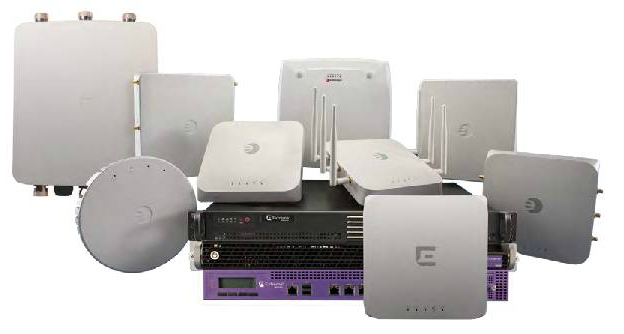
ExtremeWireless wireless networking equipment

Characteristics of ExtremeWireless access points offered today.
Outdoor Access Points
The family of access points is designed for outdoor deployment in a non-permanent climate environment — for example, for outdoor events, etc. They also provide seamless roaming in multiple campus subnets without the need for heavy client software.
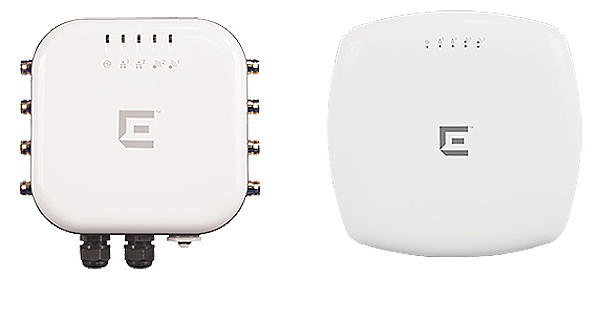
AP3965 outdoor access point

Characteristics of outdoor access points offered by the company
ExtremeWireless Controllers
ExtremeWireless controllers are easy to deploy and manage. They provide high functionality, allowing organizations to determine how wireless traffic, audio and video data will be processed without architectural constraints and in accordance with the needs of the organization.

ExtremeWireless C35 Controller

Characteristics of the controllers offered today by the company
ExtremeManagement
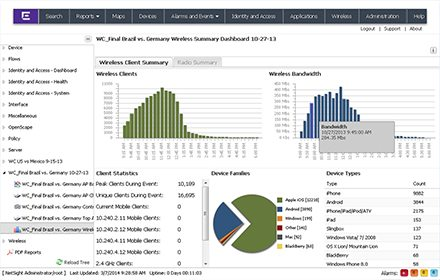
Unified management tool ─ mobile information center
ExtremeManagement keeps everything under control using role-based access controls and a single control panel. At the same time, when managing a network using ExtremeManagement, you can perform a whole range of actions with one click.
Conclusion
Of course, the economic rationale for the new solution for each organization is unique, but it is clear that Wave 2 is already here and offers real benefits for any organization using IT. Features such as 1.7 Gbps aggregate bandwidth and multi-user MIMO are not available in any other generation of Wi-Fi products.
Excellent price / performance ratio and the possibility of seamless integration into the corporate IT infrastructure remove all questions regarding capital costs. Dramatic increase in productivity ─ for both IT staff and end users ─ reduces operational costs by minimizing TCO and maximizing ROI. Additional networking capabilities in switching, management, analytics, security, and SDN naturally work with Wave 2, putting together a sufficient business case.
In other words, the time to implement and use 802.11ac Wave 2 is now.

Extreme Networks develops and delivers managed network solutions that help IT organizations improve their bottom line business results through closer connections between customers, partners, and employees.

In the last five years, the value of Extreme Networks shares did not undergo significant changes, and in the last year, with the advent of Wave 2, it has steadily increased
')
Today, Wi-Fi is the best in technology and the most convenient connectivity for users, ─ in any organization and for almost all mobile devices and applications. Therefore, the high interest of customers in solutions based on the 802.11ac Wave 2 standard is not surprising.
Improvements in wireless technologies, radio design, building access points, as well as the practice of implementations over the past two decades have already spawned several network generations: 10 Mbit / s, 100 Mbit / s, and now with 802.11ac ─ 1 Gbit / s. In fact, 802.11ac Wave 2 achieves a throughput of 1,733 Gbps.
It is important that 802.11ac Wave 2 not only provides high bandwidth, but also allows you to use almost any device and transport connection with higher performance and lower cost than ever before.

Increase Wi-Fi performance over the past 20 years
IT managers today are forced to work with reduced budgets while simultaneously requiring more and more efficiency. In this regard, the search for arguments to justify new investments from a business point of view comes to the fore.
Below are five key components of the business case for using Wave 2.
1. Understand the Benefits of Using Advanced Wireless Technologies
When discussing wireless solutions, they usually talk about their bandwidth. However, it is no longer the main problem of Wi-Fi, especially since we are talking about the generation of Wave 2 from 1.7 Gbit / s. This is quite enough to solve the majority of modern corporate tasks.
A much more important issue is ensuring support for a large and growing number of users, devices and applications, many of which use real-time audio playback and streaming video.
Even with a 33% improvement in peak throughput compared to Wave 1, Wave 2 technologies are more evolutionary than revolutionary. They are based on 802.11n innovation and are not too fundamentally different compared to 802.11ac Wave 1.
Improvements include greater spectral efficiency (fewer errors) and MIMO (Multiple Input / Multiple Output) ─ the ability to use space, not just frequency and time, which greatly increases throughput.
An additional innovation, called "beamforming", is also part of the 802.11ac standard. In a simplified presentation, beamforming is the ability to concentrate radio transmissions in the direction optimal for communications between a given access point and the client at any time, as well as to make adjustments in real time to compensate for movements and other conditions of the radio environment.
To date, all but very few products on 802.11ac have provided at most three MIMO streams, each with a maximum throughput of 433.3 Mbit / s under optimal conditions. Wave 2 works with four streams, providing 1,733 Gbps.
Interestingly, the 802.11ac standard actually defines up to eight streams. However, products that do this in practice are unlikely to become common because of their complexity and cost (at least in the foreseeable future). In addition, today most client side devices support only one (less often two) streams.
Vawe 2 Multi-User MIMO technology allows multiple users to accept a transmission that is unique to each client in a single transmission from a given access point. That is, there is no need to wait for other users to be served and to waste potential bandwidth. As a result, efficiency rises dramatically along with end-user productivity.

Schematic representation of the work of Multi-User MIMO
2. Maximum use of capital investments
Capital investments (Capital Expense, CapEx) are limited in the IT budgets of almost all companies, starting with a downturn in 2008. At the same time, the continuous flow of innovations in IT continues to affect infrastructure and equipment replacement cycles, although somewhat more slower pace than it was in the past. And, of course, careful consideration of absolute costs, and especially ROI, should today be part of all capital investment decisions.
As noted, for wireless LANs, the price / performance ratio improves with each new generation of products. But, in fact, this is due to an increase in their capacity, ─ while the prices of certain equipment (access points, etc.) remain unchanged or slightly reduced.
802.11ac Wave 2 products are fully backward compatible with Wave 1 (and even 802.11n). They work better than their predecessors, because they have a more advanced system architecture and firmware. Improvements have also affected their installations in a corporate environment that typically becomes seamless and stable.
Such an improvement in price / performance ratio with minimal installation costs raises an important question ─ is it really time to replace existing Wi-Fi solutions with Wave 2. There is no definite answer. Each organization must evaluate the purchase in terms of its depreciation cycles, available financial resources, and combination with the entire IT infrastructure and enterprise IT strategy.
However, it is obvious that any 802.11g (or earlier) solutions have definitely matured to be replaced, because too much has changed so far in terms of technical capabilities and WLAN value. Operating 802.11n systems will be under increasing pressure from Wave 2, especially if it makes sense to take advantage of the advantages of MU-MIMO.
3. Reduced operating costs
By definition, CapEx plus OpEx make up the Total Cost of Ownership (TCO). This is a key metric in determining the return on investment (ROI) and estimating capital costs over time.

Total Costof Ownership (TCO) Structure
While the 802.11ac Wave 2 capital cost component is understandable enough, operating costs (Operating Eexpense, OpEx) are a somewhat more complex subject to consider. The reason for this is that OpEx consists of aspects such as monitoring, management, support, troubleshooting, etc. They require the attention of qualified IT specialists.
Unlike CapEx, OpEx tends to increase over time ─ people become more expensive due to inflation and competition for special skills. Enterprises often cope with this problem by increasing the productivity of IT staff.
Therefore, the introduction of Wave 2 promises a significant increase in the productivity of employees of IT-departments. First of all, the improved performance of WLAN (bandwidth, capacity and support for time-limited communications, such as voice and video) will result in fewer calls to technical staff. In addition, Wave 2 will provide improved management and analytics, visibility of results and less time to troubleshoot.
And finally, regardless of how Wave 2 is implemented, ─ as a new deployment or upgrade, ─ flexible, stable and cheap seamless scalability is an integral part of Wave 2. Thus, any IT staff costs associated with the deployment of Wave 2, also minimized.
4. Improving end-user productivity
Any network strategy is best evaluated in terms of improving the performance of end users served by the network. As noted above, the number of users of wireless networks is constantly growing, ─ and not only in terms of the number of company personnel.
The spread of the Bring Your Own Device (BYOD) trend has caused a greater demand than ever before for services from users with several simultaneously active devices. Today, it is often possible to meet users who are simultaneously connected to a wireless network with two devices (a smartphone and a tablet). Not uncommon is the simultaneous use of three or four devices.
None of these devices (like the users themselves) love networks that are slow, inaccessible in certain locations, unreliable or not meeting growing needs, including support for streaming media, real-time telephony and other “heavy” communications.
New applications for the Internet of Things (IoT) also place additional demands on wireless networks. Of course, many IoT solutions will still operate with relatively little traffic. However, there are also quite heavy services ─ such, for example, as video surveillance and real-time processes. This means that the Wi-Fi network in which they operate will have needs at the Wave 2 level.
The more reliable and affordable a wireless LAN, the higher the end-user productivity. Therefore, to distribute wireless services in almost any organization, more and more MIMO and MU-MIMO streams are required.
The practical result of Wave 2 is that relatively small investments in new technologies can already provide a significant reduction in operating costs by maximizing productivity, and, accordingly, reducing TCO and increasing ROI.
5. Related Networking Technologies
Products based on 802.11ac Wave 2 embody the latest advances in features and technologies to optimize the entire chain of wireless networking. This applies to mobile clients, access points, controllers, switches and routers, management systems, etc.
Wave 2 is the technological foundation for modern wireless LANs. The network infrastructure will increasingly depend on new features and capabilities implemented in products based on Wave 2. Here are the main ones.
- Switching (Switchihg) . Wave 2 will require Power over Ethernet PoE + to realize its full potential.
- Management (Management) . This feature includes context-controlled monitoring, warnings and alarms, reporting, auditing, and more.
- Analytics . It is defined as a set of capabilities developed for the study of large amounts of data in conditions of uncertainty, that is, when it is difficult to accurately determine the subject of a search.
- Advanced security . Security is always one of the key elements on any network. Less and less, the WPA2 Wi-Fi feature is used for this (which, of course, remains important). Security is increasingly dependent on other network tools that are based on identification, access policies, context, content filtering, etc.
- Cloud . The key trend of today is the deployment of both wired and wireless networks ─ management and related functions in the cloud. The main advantages of cloud-based management ─ easy turnkey implementation, simple scalability, fault tolerance and increased security. The cost benefit of this approach is also significant, since the capital investments of the CapEx company are converted into a very economical version of OpEx.
- SDN . Software-defined networks will play a much larger role in wired and wireless networks in the coming years. The use of SDN improves network security, solution integrity, simplifies implementation, provides more comprehensive and high-quality management and analytics than traditional solutions.
Given the continuous stream of innovations in technology and Wi-Fi systems, another question arises ─ how soon will the next technology appear that will be able to supplant Wave 2?
Indeed, the IEEE 802 Standards Committee is working on new, even higher standards, but they are expected only after three years, and it will take at least five years before any of them becomes the mainstream in practice. Thus, the payback period for Wave 2 will be quite long, with a good economic justification.
Wave 2 Case Studies
This section discusses the benefits of using Wave 2 solutions in public places, education, industrial environments, corporate office networks, and healthcare.
Wave 2 in public places . Wireless traffic is growing rapidly in the hotel industry, in sports, in places of entertainment. All of them are characterized by a high density of users and devices. This motivates the demand for Wave 2 802.11ac.
Both problems and solutions for wireless LAN are often defined precisely in terms of density. Demands, after all, only grow over time. An example is IoT with its many new consumer devices, services and other applications.
Wave 2 in education . Education has always been one of the main consumers of wireless LAN. In the end, who consumes more bandwidth than students, ─ especially as the share of streaming video in the learning process increases? And who would want to go to school, where there would be no Wi-Fi?
But still, budget constraints often force many IT managers of educational institutions to use outdated systems. Wave 2 is a big step forward in solving this problem, providing greater bandwidth and being more cost-effective than any previous generation Wi-Fi.
In addition, the redundant capabilities of Wave 2 mean that the lifespan of these networks will be quite long. In a fairly conservative educational IT environment, this is an important factor.
Wave 2 in production . The production environment is usually quite complex to configure Wi-Fi services. Reliability is the most important element for wireless solutions in workshops and distribution centers, as they are related to the management of continuous flows and business processes. There may be adverse climatic conditions and radio frequency interference. In this regard, Wave 2 is ideally suited to production conditions, ensuring the continuity and flexibility of production in any environment.
Corporate Wave 2 . Almost every enterprise today, like most government organizations, depends on Wi-Fi as the main communication. In such conditions, Wave 2 is the basis on which corporate wireless network solutions will be built for quite a long time.
Wave 2 in healthcare . No IT environment is more demanding than in healthcare. Here, the main requirement is reliability in medical information systems for decisions related to human life ...
So much depends on the wireless LAN, which provides the best protection, capabilities, and reliability for patient communications and telemetry, as well as low-latency access to large (and often very large) data volumes produced by Computed Tomography (CT) devices and Magnetic Resonance Imaging (Magnetic Resonance Imaging, MRI). Wave 2 today is in this respect the best technology for the healthcare industry.
The range of Wave 2 Extreme Networks
Today, the company offers a variety of access points, including weatherproof outdoor devices, controllers for wireless networks, and control software.
ExtremeWireless Access Points
ExtremeWireless access points provide the performance of today's wired networks for the high-density network environment. Smart Access Points are equally well suited for both distributed and centralized deployment models.

ExtremeWireless wireless networking equipment

Characteristics of ExtremeWireless access points offered today.
Outdoor Access Points
The family of access points is designed for outdoor deployment in a non-permanent climate environment — for example, for outdoor events, etc. They also provide seamless roaming in multiple campus subnets without the need for heavy client software.

AP3965 outdoor access point

Characteristics of outdoor access points offered by the company
ExtremeWireless Controllers
ExtremeWireless controllers are easy to deploy and manage. They provide high functionality, allowing organizations to determine how wireless traffic, audio and video data will be processed without architectural constraints and in accordance with the needs of the organization.

ExtremeWireless C35 Controller

Characteristics of the controllers offered today by the company
ExtremeManagement

Unified management tool ─ mobile information center
ExtremeManagement keeps everything under control using role-based access controls and a single control panel. At the same time, when managing a network using ExtremeManagement, you can perform a whole range of actions with one click.
Conclusion
Of course, the economic rationale for the new solution for each organization is unique, but it is clear that Wave 2 is already here and offers real benefits for any organization using IT. Features such as 1.7 Gbps aggregate bandwidth and multi-user MIMO are not available in any other generation of Wi-Fi products.
Excellent price / performance ratio and the possibility of seamless integration into the corporate IT infrastructure remove all questions regarding capital costs. Dramatic increase in productivity ─ for both IT staff and end users ─ reduces operational costs by minimizing TCO and maximizing ROI. Additional networking capabilities in switching, management, analytics, security, and SDN naturally work with Wave 2, putting together a sufficient business case.
In other words, the time to implement and use 802.11ac Wave 2 is now.
Source: https://habr.com/ru/post/334024/
All Articles